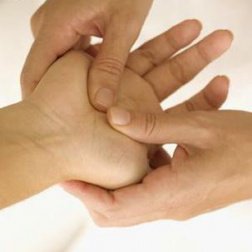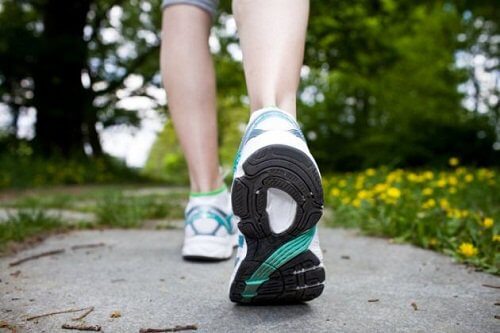Why Are You Feeling Tingling in Your Arms and Legs?

There’s no doubt this is an unpleasant sensation. When your arms, hands, legs, or feet fall “asleep” it’s hard to know what to do to wake them back up and get things feeling normal again. Find out why you’re experiencing tingling in your arms and legs in today’s article!
Numbness and tingling: what is it? What’s causing it?
Both numbness and tingling are unusual sensations that can pop up anywhere in the body. But most often people experience them in their arms, legs, hands, fingers, and feet. Some of the most common reasons why you could experience tingling in your arms and legs are:
- Staying in the same position for extended periods of time, whether it be standing or sitting (for example, while traveling or at your desk at work)
- Nerve injury – if you injure a nerve in your neck, you’ll experience these feelings in your arms and hands; if it’s in your lower back, it’ll affect your legs and feet

- Pressure on the spinal or peripheral nerves
- Herpes zoster (or shingles) infection
- A lack of blood flow caused by inflammation of the blood vessels, atherosclerosis, or a blood clot
- Unbalanced levels of potassium, calcium, or sodium
- Lack of vitamin B12
- Taking certain medications
- Nerve damage due to excessive alcohol consumption, smoking, or lead exposure
- Radiotherapy
- Stinging insects, mites, or animal bites
- Allergies to shellfish
- Carpal tunnel syndrome (in the wrist)
- Diabetes
- Hypothyroidism
- Stroke or other ischemic attack
Home remedies and recommendations to alleviate tingling in your arms and legs
Water is one of the best natural ways to “wake up” your legs and hands when they’re numb. Soak the affected area in a bowl of cold water for about 10 minutes, or until the tingling stops. Some people also choose to forcefully move their fingers, toes, or any part of their body that feels numb. Some other options are:
Walking
Take a short walk around the room when you start to feel that tingling in your arms and legs coming on. You might have to stand still for a few minutes if you’re experiencing spasms in one of your legs, but moving around is a pretty effective way to wake up your limbs, particularly if you’ve been sitting still for a long time.

Standing on your tiptoes
This is another treatment for numb legs. Stand on your tiptoes as if you were a dancer, and then lower your heels to the floor. Then repeat this 10 times to stimulate circulation in your lower limbs. If your legs and feet tend to go numb a lot, do this exercise every evening before you go to bed so you don’t experience numbness while you sleep.
Eat more foods that are rich in iron
An iron deficiency could be causing the tingling in your arms and legs. Adding lentils and beets to your diet can help reduce the frequency in which you suffer from this. It’s also a good idea to eat more eggs, milk, nuts, peas, beans, and green leafy vegetables like spinach and chard.
Read also:
8 Remarkable Benefits of Eating Lentils
Make a compress using hot peppers
This can help alleviate your situation. You’ll need a dozen red chili peppers. Cook them over high heat, then press them through a cloth. Apply this compress to the affected area. The heat from the peppers will reduce any pain and discomfort. If you suffer from this problem often, you can have an ointment prepared and ready to warm up at a moment’s notice.
Avoid certain foods and drinks
Drinking coffee or alcohol during and after dinner is not advised. Nor is eating heavy foods in the evening.
Lead a healthier lifestyle
Quit smoking, get exercise through activities like swimming, practice relaxation therapies like yoga to reduce tension, avoid spending too much time in the same sitting or standing position, and wear looser fitting clothing to allow a better circulation.

Massages and changing your posture
When you start to feel that tingling in your arms and legs coming on, it’s a good idea to vigorously massage or rub the area. You can even do this every night in anticipation of one of your limbs going numb.
Another good tactic is to change your position often. If you’re sitting down, stand up; if you’re lying down, sit up and if you’re standing, sit down…and so on. If you find that your legs and arms are tingling while you sleep, it could be because you’re staying in the same position for long periods of time without moving. Try using pillows to elevate the areas that are affected.
Wear appropriate footwear
You should always choose socks made of cotton or wool to absorb moisture and prevent tingling. Change your socks three times a day (every 8 hours).
Your shoes should be comfortable and made of leather or fabric. Make sure they have adequate arch support or use inserts to support your feet better. Try not to wear high heels or shoes that cause you to slip while walking – make sure they have good soles.
Do wall or ball exercises
When you get home from work, especially if you’re experiencing tingling or if your legs are numb, take off your socks and shoes and stand with your back against the wall. Press your fingers and palms against the wall and bend your knees slightly.
In your office at work, take a rubber ball in the palm of your hand and push as hard as you can. There are accessories made exactly for this kind of exercise. You can do the same exercise with your legs and feet by pushing the rubber ball towards the ground with the soles of your feet.
All cited sources were thoroughly reviewed by our team to ensure their quality, reliability, currency, and validity. The bibliography of this article was considered reliable and of academic or scientific accuracy.
- Aguilar-Juárez, P., Castillo-Lara, R., Ceballos-Godina, M., Colorado-Ochoa, H., Espinosa-Zacarías, J., Flores-Ramírez, F., García, S., García-Huerta, L., González-Cruz, M., Granados-Aguilar, M., León-Jiménez, C., Llamas-López, L., Martínez-Gurrola, M., Núñez-Orozco, L., Quiñones-Aguilar, S., Sauri-Suárez, S., Solórzano-Gómez, E., & Vega-Gaxiola, S. (2019). Consenso para el diagnóstico y tratamiento de la esclerosis múltiple en pacientes del ISSSTE. Medicina interna de México, 35(5), 732-771. https://www.scielo.org.mx/scielo.php?script=sci_arttext&pid=S0186-48662019000500732
- Bair, M. J., & Krebs, E. E. (2020). Fibromyalgia. Annals of internal medicine, 172(5), 33–48. https://pubmed.ncbi.nlm.nih.gov/32120395/
- Banda, R., Horta, C., & Manjarrez, J. (2022). Trastorno de ansiedad generalizado – una revisión del estado del arte. Revista Sanitaria de Investigación, 3(11). https://dialnet.unirioja.es/servlet/articulo?codigo=8707986
- de Sequera Ortíz, P., Alcázar Arroyo, R., & Albalate Ramón, M. (2021). Trastornos del Potasio. Hipopotasemia. Hiperpotasemia. Nefrología al día. https://www.nefrologiaaldia.org/es-articulo-trastornos-del-potasio-hipopotasemia-hiperpotasemia-383
- Diaz, M. M., Keltner, J. R., Simmons, A. N., Franklin, D., Moore, R. C., Clifford, D., Collier, A. C., Gelman, B. B., Marra, P. D. C., McCutchan, J. A., Morgello, S., Sacktor, N., Best, B., Notestine, C. F., Weibel, S. G., Grant, I., Marcotte, T. D., Vaida, F., Letendre, S., Heaton, R., … Ellis, R. J. (2021). Paresthesia Predicts Increased Risk of Distal Neuropathic Pain in Older People with HIV-Associated Sensory Polyneuropathy. Pain medicine (Malden, Mass.), 22(8), 1850–1856. https://pubmed.ncbi.nlm.nih.gov/33565583/
- Estrada, K. M., Rodriguez, T. C., Blanco, I. M., & Méndez, L. G. (2013). Manifestaciones neurológicas por déficit aislado de vitamina B12. Medicina De Familia. Semergen, 39(5), e8-e11. https://www.elsevier.es/es-revista-medicina-familia-semergen-40-articulo-manifestaciones-neurologicas-por-deficit-aislado-S1138359312001669
- Feldman, E. L., Callaghan, B. C., Pop-Busui, R., Zochodne, D. W., Wright, D. E., Bennett, D. L., Bril, V., Russell, J. W., & Viswanathan, V. (2019). Diabetic neuropathy. Nature reviews. Disease primers, 5(1), 41. https://pubmed.ncbi.nlm.nih.gov/31197153/
- Félix-Redondo, F. J., Subirana, I., Baena-Diez, J. M., Ramos, R., Cancho, B., Fernández-Bergés, D., & Robles, N. R. (2020). Importancia pronóstica de la enfermedad arterial periférica diagnosticada mediante el índice tobillo-brazo en población general española [Prognostic importance of diagnosticated peripheral arterial disease through the ankle brachial index in spanish general population]. Atencion primaria, 52(9), 627–636. https://www.ncbi.nlm.nih.gov/pmc/articles/PMC7713094/#:~:text=La%20enfermedad%20arterial%20perif%C3%A9rica%20(EAP,de%20causa%20mayoritariamente%20ateroscler%C3%B3tica1.
- Fundación Femeba. Neuropatía periférica por medicamentos. (2018). Consultado el 29 de mayo de 2023. https://www.fundacionfemeba.org.ar/blog/farmacologia-7/post/neuropatia-periferica-por-medicamentos-45548
- Garnacho-Saucedo, G., Salido-Vallejo, R., & Moreno-Giménez, J. (2013). Actualización en dermatitis atópica. Propuesta de algoritmo de actuación. Actas Dermo-Sifiliográficas, 104(1), 4-16. https://www.sciencedirect.com/science/article/pii/S0001731012001093
- Khaku, A. S., & Tadi, P. (2022). Cerebrovascular Disease. StatPearls. Consultado el 29 de mayo de 2023. https://pubmed.ncbi.nlm.nih.gov/28613677/
- Navarro, W., Cañarte-Alcívar, J., & Guerra, J. B. A. (2019). Consideraciones clínicas e inmunológicas del hipotiroidismo subclínico: Una revisión documental. Revista Arbitrada Interdisciplinaria de Ciencias de la Salud, 3(6), 818. https://fundacionkoinonia.com.ve/ojs/index.php/saludyvida/article/view/392
- Parestesia | NINDS Español. (2022). Consultado el 29 de mayo de 2023. https://espanol.ninds.nih.gov/es/trastornos/parestesia
- Patil, A., Goldust, M., & Wollina, U. (2022). Herpes zoster: A Review of Clinical Manifestations and Management. Viruses, 14(2), 192. https://www.ncbi.nlm.nih.gov/pmc/articles/PMC8876683/
- Sadowski, A. (2022). Alcoholic Neuropathy. StatPearls. Consultado el 29 de mayo de 2023. https://www.ncbi.nlm.nih.gov/books/NBK499856/
- Sevy, J. O., & Varacallo, M. (2022). Carpal Tunnel Syndrome. StatPearls. Consultado el 29 de mayo de 2023. https://pubmed.ncbi.nlm.nih.gov/28846321/
- Tabares Neyra, H., Díaz Quesada, J., Tabares Sáez, H., & Tabares Sáez, L. (2016). Hernia discal lumbar, una visión terapéutica. Revista Cubana de Ortopedia y Traumatología, 30(1), 27-39. http://scielo.sld.cu/scielo.php?script=sci_arttext&pid=S0864-215X2016000100003
- Torres, A. S., & Ruiz, T. M. (2015). Protocolo diagnóstico de las alteraciones sensitivas asimétricas. Medicine – Programa De Formación Médica Continuada Acreditado. https://www.sciencedirect.com/science/article/abs/pii/S0304541215000864
- Vázquez, R. G., Velasco, M. F., Fariña, M. M., Marqués, A. M., & De La Barrera, S. S. (2017). Actualización en lesión medular aguda postraumática. Parte 1. Medicina Intensiva, 41(4), 237-247. https://www.medintensiva.org/es-actualizacion-lesion-medular-aguda-postraumatica–articulo-S021056911630239X
This text is provided for informational purposes only and does not replace consultation with a professional. If in doubt, consult your specialist.








